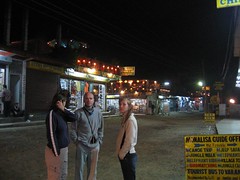
Night life in Sauraha
Originally uploaded by bastchild.
Not a busy place.
a travelogue for a solo cross-country motorcycle road trip from Tampa, Florida to San Diego, California in 2008 and an overland attempt from Singapore to Morocco from November 2004 to August 2006
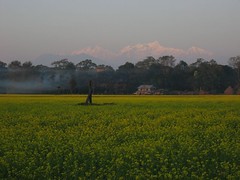
Manaslu (8162-m) was readily visable even though it was about 60 miles away.
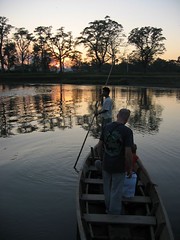
We rented bikes for an hour and rode through villages to the Elephant Breeding Center. A free boatride took us across the river. The elephant center was closing soon, but it was pretty unremarkable from the ticket center; just a big roofed area for the many tied-up elephants and a few babies.
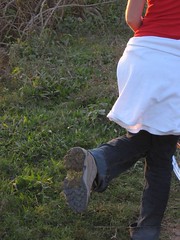
With so many elephants walking around, you could easily step into a big elephant turd loaf. Some people even relished it.
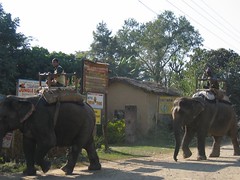
Sauraha is just outside Chitwan National Park. Hotel packages inside the park start at about $100/night. We stayed in Sauraha and paid $2/night. Big tourist options here include jeep safaris, elephant safaris, canoe rides, and jungle walks. Here you can see handlers bringing their elephants to the tourists.

Disliking the tourist prices in the restaurant serving Western food, we opted for samosas (5 Rs each) and noodles (30 Rs a plate).
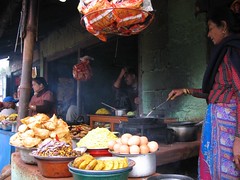
From Kathmandu, we all booked a bus to Sauraha, just outside Chitwan National Park. The national park lies halfway between Kathmandu and Pokhara, along the Indian border. This park was said to contain about 110 Bengal tigers and 500 rhinos. The early morning bus stopped here for breakfast. It was 55 Rs for two of us.
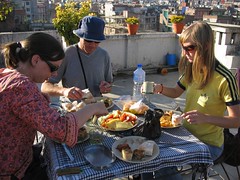
We bought cheese, bread, vegetables, sardines, olives, quiche, pastries, "cron" chips, bhaji mix, and Spanish red wine for a rooftop picnic. Wonderful times on the roof sipping Spanish wine, Nepalese rum and coke, and gin & tonic.
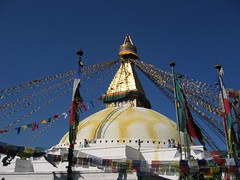
We got in for free by walking through a side alley. As it turns out, there are ticket booths for foreigners, but not locals and there are usually only one ticket booth entering a site, so you just have to find an alternative entry point.
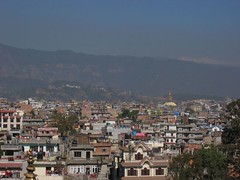
From Pashupatinath, it is a forty minute walk to Bodhnath, the largest stupa in Nepal, and one of the largest in the world.

This ghat was for royalty or wealthier people, or Brahmins, or the priestly caste. This is just the funeral pyre without the body. Later, mourners and pallbearers appeared with the body on a bamboo stretcher and brought the body to a ramp at the bottom of the steps. They took turns pouring milk and water from the Bagmati into the deceased mouth (to purify her), then they brought the body to the pyre to burn. Loads of observers, mostly Nepalese, stood on the bridge and opposite bank to watch.
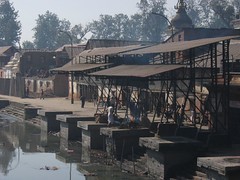
Pashupatinath Temple, the most holy temple for Nepalese Hindis. Like Varanasi on the Ganges, this temple sits on the Bagmati River, their holy river, where a cremation and toss of their remains into the river results in a one-way trip to nirvana. These cremation ghats (steps leading to the river) were for common folks.
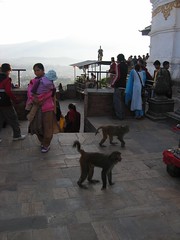
Swayambhunath Temple is a Buddhist temple on a hill high above Kathmandu. It is a great viewpoint for the city and is loaded with monkeys, earning the nickname "Monkey Temple". As it turns out, there are monkeys at most temples anyways...
There were lots of Tibetans here; I could smell their mutton and sheep-lined coats as I passed them on the stairs. In 1957, loads of Tibetans fled into Nepal escaping Chinese persecution.
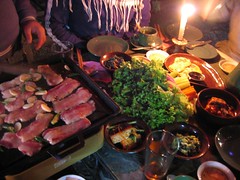
We grilled strips of pork on a hot plate and wrapped it with leaves of lettuce and rice and kimchi. There were loads of pickled dishes to taste.
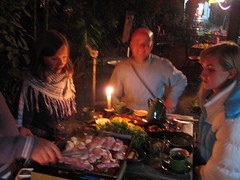
After a few days in Kathmandu, we ran into Simon and Annabel again. They had blazed through the rest of the Annapurna Circuit, completing the 18-21 day trek in merely 13 days! We celebrated their return with a visit to the Korean bbq restaurant. Simon was looking a little blurry after such a fast and hard trek.
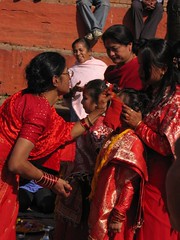
There was this ceremony going on in Durbar Square. About four or five young girls were seated behind some gifts and foods with their mothers behind them. This lady came up and painted their foreheads with red paint.
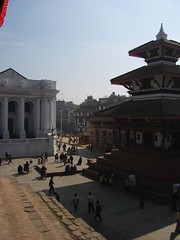
Where Kathmandu's street life breathes, apparently. This was the castle square where kings were crowned. It was a stiff 200 Rs admission fee for foreigners, but I walked through without being stopped. There are a lot of different temples and shrines here amongst the marigold sellers and sadhus.
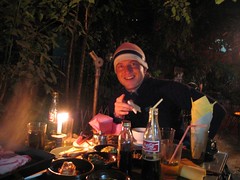
Mike had just entered Asia a month ago, but was planning on catching a cargo ship out of Hong Kong to spend the holidays in Mexico.
He had gone overland with Stu and the Koreans, but was flying back to China (to Shanghai) at 3am that night. It turns out he didn't do that at all. I saw him the next morning in line at the Indian Embassy; he was changing his plans entirely and going to India!

Joon was picked up by the overland jeep hitchhiking across Tibet. He had bought a horse and was riding it to Everest Base Camp. He's a martial arts instructor for the South Korean army.
Pyo was on holiday for two months, doing Tibet, Nepal, and India. She spoke fluent Mandarin even though she had only studied it for the past 18 months.
The pair of them cooked up some Korean barbecue for us -- samyalsang, or something like that.
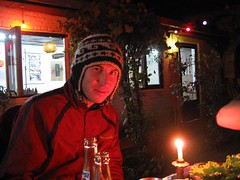
I ran into Stu in Kathmandu. We had left him in Lhasa, but he did the overland trip a week after with some Koreans and a Canadian. We met up with him for dinner at a Korean restaurant.
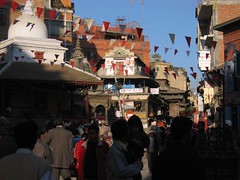
This time in Kathmandu, I actually visited more of the city outside the Thamel tourist ghetto.
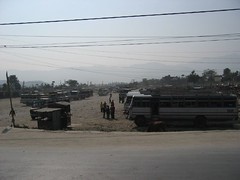
On approach to Pokhara, I spied the bus station at the end of the airstrip, so I promptly headed for after getting my luggage. After hiking all week long, the hike to the end of the airstrip was a short walk. I found the next bus to Kathmandu (leaving in ten minutes) and was well on my way to Kathmandu within an hour. I arrived to Kathmandu around 1900 that evening. It was colder than it had been over a week ago, but I was glad to be back.
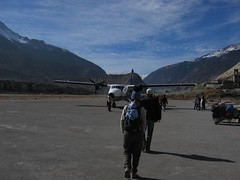
The flight was scheduled for 0730 and required a show-up time of 0700. As expected, though, the flight didn't show up until 1030 because of fog in Pokhara. This gave me time to get some breakfast at my guesthouse until the air raid siren announced an incoming plane.
It was a pretty turbulent take off heading into the strong winds in the valley. Twenty minutes later, when we arrived in Pokhara, three Chinese girls clambored out of the 18-seater twin-prop plane and quickly vomitted on the grass next to the tarmac.

Walking through Jomsom, I ran into Simon and Annabel! They had left Kathmandu to start the Annapurna Circuit the day before I did (so four days ahead of me in total, starting on the other end of the trail).
They had hiked very fast, skipping acclimatization days before tackling the Thorung-La Pass (5416 m). They reckoned it was the high altitude of Tibet that kept them from getting sick. The pass was icy and dangerous from a early storm the month before (the same one that put snow on the hills in Tibet on our last day of driving there).
It was great meeting up with them, especially since it was purely coincidental -- we were late in arriving in Jomsom, and they were early. We agreed to meet up in Kathmandu in a few days as they were continuing to Marpha for the night.
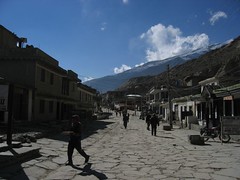
Only four hours after leaving Tuguche, I arrived in Jomsom, the end of the Jomsom trek. It had an airport, a bank (with ATM), and more expensive hotels and food. From here, Emily and I bought a couple seats on the next Shangrila Air flight to Pokhara in the morning (only $64).
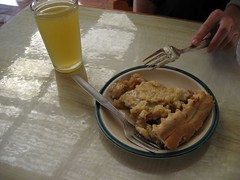
I stopped in Marpha for a mid-morning splurge. All through the trek, I had usually been spending about 250 Rs a day. For a room, Emily and I were able to bargain them down to 50 Rs for the two of us, and dal bhat cost 120 - 150 Rs. Breakfast was usually a shared cup of hot milk (that we mixed with some packaged museli cereal we had brought along), and lunch was trekking bread (from a "German bakery" in Pokhara) that lasted all week without getting moldy or hard, hard cheese, and bhaji mix (dal mut). Water was free filtered stuff from the guesthouses that I refilled in the mornings and evenings.
This was our last day of trekking, so we splurged and had some apple cider (20 proof) and apple crumble (absolutely delicious) in Marpha, the declared "apple capital of Nepal". We had left Maoist territory when we entered Tatopani and a government-sponsored program in the valley grew various fruits in orchards. There was also some apple brandy that we picked up in Tuguche (where there is a distillery), but it was horrible-tasting.
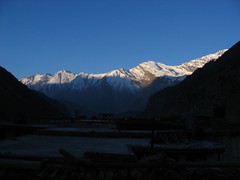
In Tuguche, I met an interesting German traveller. He was 45 years old and had been travelling for the past ten years, and declared that ten years ago he decided he was going to travel and never work again. He had travelled extensively in Latin America, SE Asia, China, and India. He travelled for about eleven months at a stretch before returning to a base of operations, this time in Hat Yai, on the Thai-Malay border, where he had a rented apartment. On this trip, he had spent six months (three months at a time) in China, and four months in India, and had planned on being in Nepal for two months. This was his second time in Nepal. He was going to go back to Germany for about a month before returning to China for a few more months to explore the Sichuan and Yunnan provinces. He was a very strange character, having already spent 31 days on the Annapurna Circuit (I met him on his 18th rest day). It normally takes folks 18-21 days to hike the Circuit. He had a few books to keep him company, which described the flora and fauna of the region. He explained that he had worked for nine years before his retirement. I have no idea what he did, but he seemed to indicate various jobs. Surprisingly, talking to him about what he did was immensely uninspiring and I knew I could never do what he did.
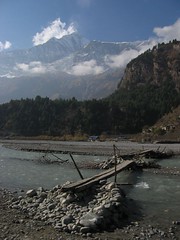
I wasted almost an hour in the basin, trying to find the right crossing points, and deciding between jumping across rivulets or continuing on forward. I ended up getting both feet wet before I found a series of these plank bridges.
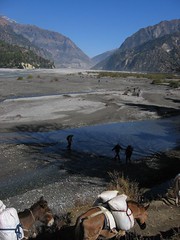
The wind through this basin was pretty strong, with dust-clouds in the distance. I was later told that the wind was at its mildest this day. Lucky me.
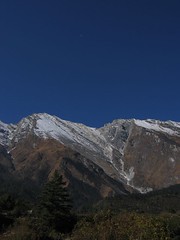
Here's a photo for slab climbers -- this massive sheet of rock goes to the peak -- one long slab climb. Not for the weak or weary!

I spent my fourth night in Ghasa (2120-m), which was unimpressive and cold when I arrived there. It was a mild uphill climb from Tatopani, only a few hundred meters. From Ghasa, I headed for Tukuche (2590-m), which, again, was a pretty flat track, only five hours long, but required some route-finding through a river basin.
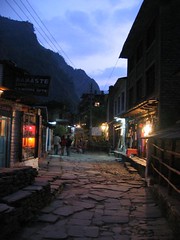
The first touristy town on the trek with bars and souvenir shops. It is the middle of a shorter trek out of Pokhara called the Annapurna Panorama. Who the heck buys souvenirs when you have to carry them out?
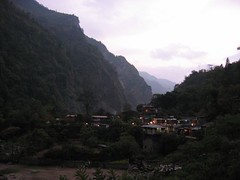
After a seven hour day (almost all down hill), we came to Tatopani, the largest town thus far on the trek. I had thought the downhill portion (about 1600 meters descent) would be easy, but the next morning, my calves were killing me!
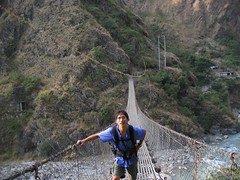
There are numerous suspension bridge crossings on the trek, most of the quite modern and sturdy, built by Swiss NGOs.
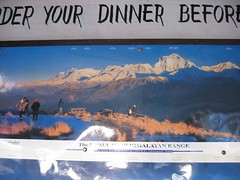
The view I didn't see in the morning. It was cloudy and misty the night before, but sure enough, the morning was nice and clear. Oh well.
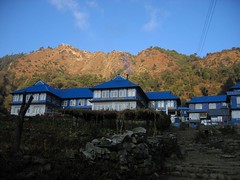
Five hundred meters higher than Ghorapani, I didn't feel like getting up in the predawn darkness to hike up there to view the sunrise off of the Annapurnas. Instead, I slept in to 0700 and warmed myself by the stove in the restaurant.
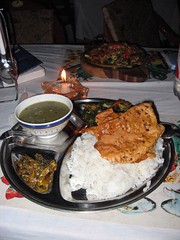
At the Ghorapani Lodge, I had my best dal bhat, thick with ginger, plenty of pickles and vegetables and a papadam. We were the only guests at the Lodge, owned by an ex-British Gurkha soldier (16 years in service with combat experience all over Oceania). He had some interesting things to say about the Maoists, whom he did not support, even though they occupied the district.
He explained that the money Maoists extorted never went to "the people" but just lined their own individual pockets, making some of them wealthy enough to buy a couple homes in India (by his reckoning). He compared them to organized robbers.
While on the trek, I ran into many school-aged kids who would immediately put on a cute face and ask for "one pen, paper, book, sweet, ruppee?". Clearly there are trekkers who encourage begging from these kids. I reckon these kids end up growing up to become Maoists so they can extort more stuff from trekkers. It is interesting that while the villagers (farmers and such) have adapted by opening their homes to trekkers who will pay for room and board, the Maoists complain about being poor and robbing people, all in the name of "justice".
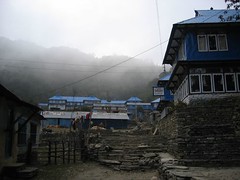
After seven hours of hiking, I reached Ghorapani. Two days of uphilling trekking about 1000-m each day and I was beat. In this town, I started to see Maoist guerrilla grafitti. In fact, this is where the Maoists are said to extort 1200 Rs from each trekker. I was lucky to encounter none. In fact, there was a ceasefire at the time and secret negotiations to become a mainstream political party.